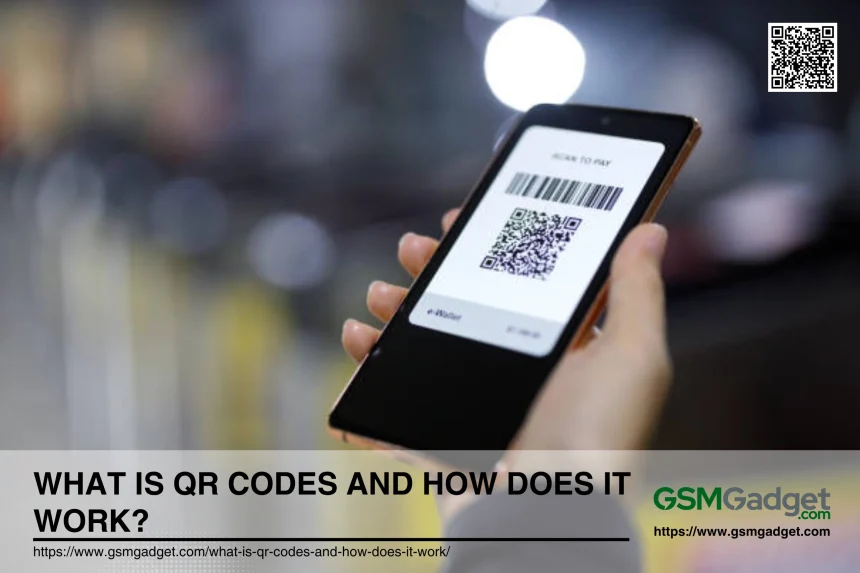QR codes, short for Quick Response codes, are a type of two-dimensional matrix barcode. They were invented in 1994 by Denso Wave, a subsidiary of the Japanese company Denso Corporation, primarily to track automobile parts during manufacturing. The QR code system was developed by a team led by Masahiro Hara, who drew inspiration from the game of Go, using black and white squares to create a code that could be read quickly and store a large amount of data. More information on the history of QR codes can be found online.
Comparison with Traditional Barcodes
While traditional barcodes are one-dimensional and can only store up to 100 alphanumeric characters, QR codes are two-dimensional and can hold significantly more information—up to 7,089 characters. This increased capacity is due to their ability to store data both horizontally and vertically. Traditional barcodes are typically scanned using specialized devices, whereas QR codes can be scanned using most modern smartphones, making them more versatile and accessible.
Types of QR Code
There are several types of QR codes, each serving different purposes. Static QR codes are fixed and cannot be edited once created, making them ideal for simple, unchanging information like URLs or contact details. Dynamic QR codes, on the other hand, can be updated and tracked, offering flexibility for marketing campaigns and data collection. QR Code Model 1 and Model 2 differ in their data capacity and error correction levels, with Model 2 being more advanced and widely used. Micro QR codes are smaller and used for applications where space is limited, such as on small products. Lastly, iQR codes can store more data and come in both square and rectangular shapes, providing versatility for various uses.
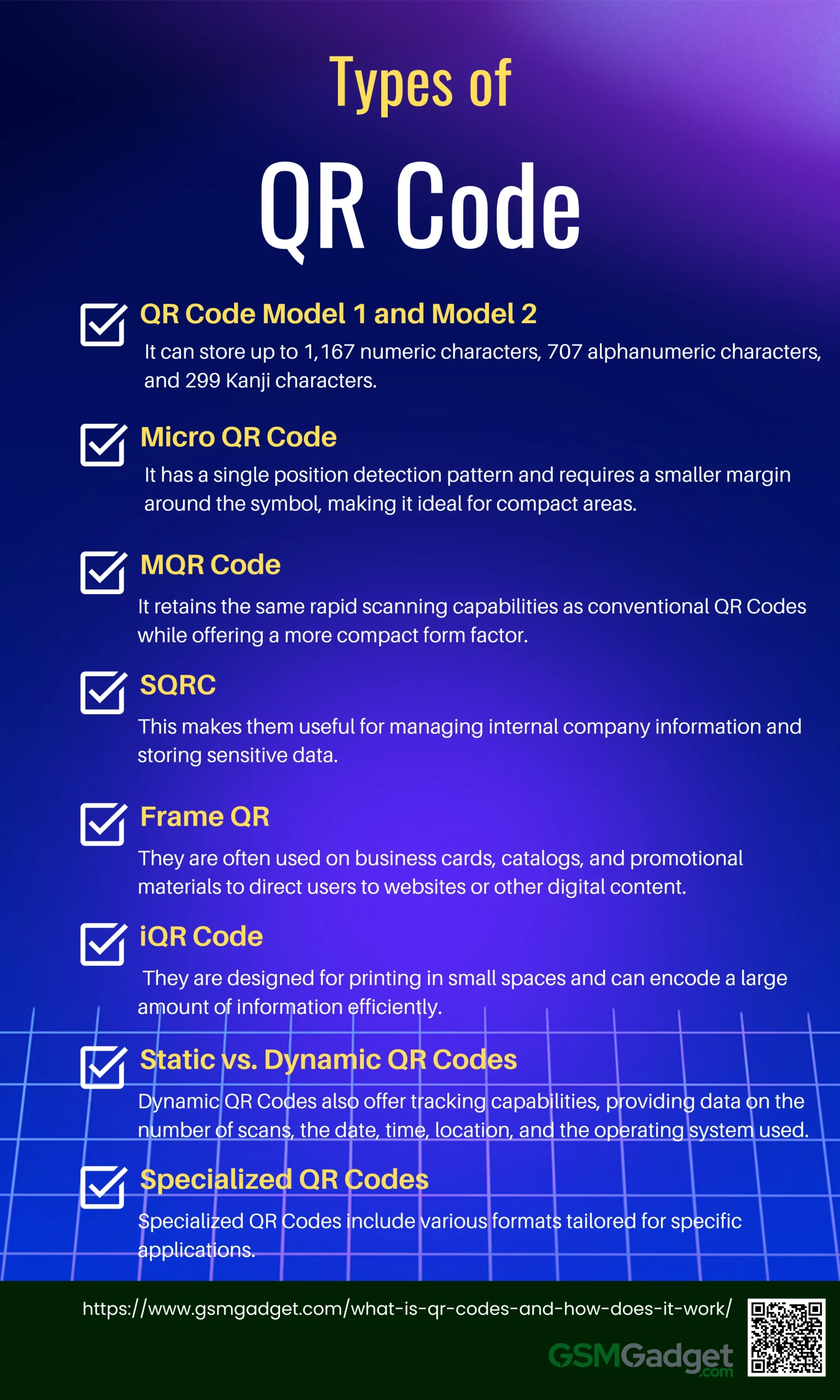
1. QR Code Model 1 and Model 2
QR Code Model 1 is the original design created by Denso Wave in 1994. It can store up to 1,167 numeric characters, 707 alphanumeric characters, and 299 Kanji characters. However, it has limited error correction and scannability compared to its successor, QR Code Model 2. Model 2 can store up to 7,089 numeric characters, 4,296 alphanumeric characters, 2,953 binary bytes, and 1,817 Kanji characters. It also includes an alignment pattern that makes it easier to detect and read, even if the code is distorted.
2. Micro QR Code
Micro QR Code is a smaller version of the standard QR Code, designed for applications where space is limited. It has a single position detection pattern and requires a smaller margin around the symbol, making it ideal for compact areas. Micro QR Codes can store up to 35 numeric characters or 21 alphanumeric characters, depending on the version used.
3. MQR Code
The Rectangular Micro QR Code (rMQR Code) is a matrix-type, two-dimensional code that is designed for narrow spaces. It can store up to 361 numeric characters and has a rectangular shape, making it suitable for applications where traditional QR Codes cannot fit. It retains the same rapid scanning capabilities as conventional QR Codes while offering a more compact form factor.
4. SQRC
Secure Quick Response (SQRC) codes are equipped with a reading restriction function, allowing them to store private information that can only be read by specific types of scanners. This makes them useful for managing internal company information and storing sensitive data. Despite their added security features, SQRCs look identical to regular QR Codes and retain all standard functionalities, including error correction.
5. Frame QR
Frame QR codes include a customizable area or frame for holding an image. This flexibility in shape and color makes them ideal for branding and marketing purposes. Frame QR codes can integrate illustrations or logos, making them stand out and encouraging more scans. They are often used on business cards, catalogs, and promotional materials to direct users to websites or other digital content.
6. iQR Code
iQR Codes are an advanced version of QR Codes that offer up to 80% higher data capacity and the option for a rectangular symbol. They are designed for printing in small spaces and can encode a large amount of information efficiently. iQR Codes support various character sets, including numeric, alphanumeric, byte, and Kanji, and offer high levels of error correction, allowing them to be read even if partially damaged.
7. Static vs. Dynamic QR Codes
Static QR Codes encode information directly into the code and cannot be edited once created. They are ideal for simple, unchanging data like URLs or contact information. In contrast, Dynamic QR Codes use a short URL that redirects to the desired content, allowing for the information to be updated even after the QR Code has been printed. Dynamic QR Codes also offer tracking capabilities, providing data on the number of scans, the date, time, location, and the operating system used.
8. Specialized QR Codes
Specialized QR Codes include various formats tailored for specific applications. For example, Wi-Fi QR Codes allow users to connect to a network without entering a password, while Audio and Video QR Codes can embed multimedia content. Other specialized QR Codes can link to documents, presentations, or app download pages, enhancing the user experience by providing quick access to additional resources.
How QR Code works
QR codes work by encoding information into a two-dimensional matrix of black and white squares, which can be scanned and interpreted by a QR code reader or smartphone camera. When a QR code is scanned, the reader deciphers the pattern of squares to retrieve the stored data, which can include URLs, text, contact information, or other types of content. The process involves the reader detecting the three distinctive squares at the corners of the QR code to determine its orientation, followed by decoding the smaller squares within the grid. This data is then translated into a human-readable format or action, such as opening a website or displaying a message, making QR codes a versatile tool for quickly accessing digital information.
Scanning Process
QR codes are scanned using smartphone cameras or dedicated QR code readers. On an Android device, you can simply open the camera app, point it at the QR code, and a notification will appear with the encoded information or a link to a website. The camera captures the image of the QR code, and specialized software decodes the pattern of black and white squares to extract the stored data. This process is facilitated by fiducial markers in the QR code, which help the software determine the orientation and alignment of the code for accurate reading.
Data Encoding
QR codes can encode data in four different modes to maximize efficiency:
- Numeric: Encodes digits (0-9) and is the most efficient mode for numerical data.
- Alphanumeric: Encodes a combination of digits and alphabetic characters (0-9, A-Z, and some special characters).
- Byte/Binary: Encodes binary data, suitable for text and other types of data.
- Kanji: Encodes characters from the Japanese Kanji character set.
These modes allow QR codes to store various types of information, like URLs, text, contact details, and more. For example, a QR code can link to a website, store a vCard for contact information, or even trigger an email or SMS when scanned.
Error Correction
QR codes are designed to be robust, even if they are partially damaged. This is achieved through Reed-Solomon error correction. This algorithm adds redundant data to the QR code, allowing it to be read accurately even if up to 30% of the code is damaged. There are four levels of error correction:
- Level L: Recovers 7% of data.
- Level M: Recovers 15% of data.
- Level Q: Recovers 25% of data.
- Level H: Recovers 30% of data.
The choice of error correction level depends on the expected operating environment and the amount of data to be encoded. Higher levels of error correction increase the size of the QR code but provide better resilience against damage.
Applications of QR Codes
QR codes have a wide range of applications across various industries. In marketing, they are used to direct consumers to websites, promotional content, or social media pages quickly. Retailers use them for contactless payments and to provide detailed product information. In the healthcare sector, QR codes facilitate patient data management and medication tracking. They are also employed in logistics for tracking shipments and inventory management. Additionally, QR codes enhance event management by enabling easy ticket verification and attendee check-ins. Their versatility and ease of use make QR codes an invaluable tool for streamlining processes and enhancing user engagement.
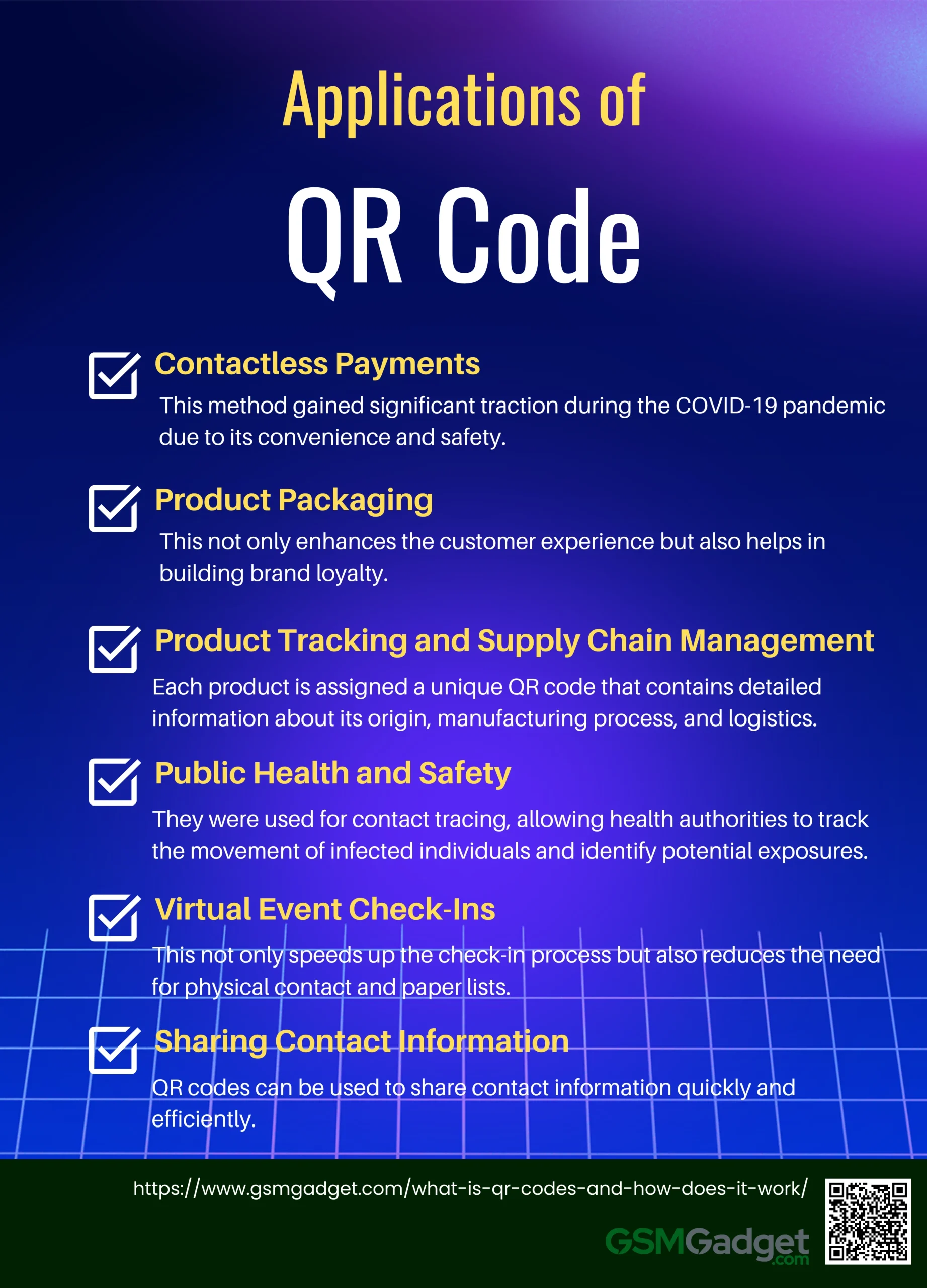
1. Contactless Payments
QR codes have revolutionized the way businesses handle transactions by enabling contactless payments. Customers can simply scan a QR code with their smartphone to complete a purchase, eliminating the need for physical cash or cards. This method gained significant traction during the COVID-19 pandemic due to its convenience and safety.
2. Product Packaging
Businesses often use QR codes on product packaging to provide additional information, such as product details, usage instructions, or promotional offers. This not only enhances the customer experience but also helps in building brand loyalty.
3. Product Tracking and Supply Chain Management
QR codes are extensively used in supply chain management to track products from origin to destination. Each product is assigned a unique QR code that contains detailed information about its origin, manufacturing process, and logistics. This ensures transparency and helps in mitigating risks associated with counterfeiting and quality control. For instance, logistics companies can scan QR codes on shipping labels to access real-time information about a shipment’s status, location, and delivery schedule.
4. Public Health and Safety
During the COVID-19 pandemic, QR codes played a crucial role in public health efforts. They were used for contact tracing, allowing health authorities to track the movement of infected individuals and identify potential exposures. By scanning a QR code at various locations, individuals could check in and out, providing a digital record that could be used for tracing contacts in case of an outbreak. This automated decision-making process helped in controlling the spread of the virus and managing public health data efficiently.
5. Virtual Event Check-Ins
QR codes simplify the check-in process at virtual and physical events. Attendees receive a QR code in their confirmation email or event app, which they can scan upon arrival to gain entry. This not only speeds up the check-in process but also reduces the need for physical contact and paper lists.
6. Sharing Contact Information
QR codes can be used to share contact information quickly and efficiently. For example, a QR code on a business card can link directly to a person’s LinkedIn profile or a digital vCard, making it easy to save contact details without manual entry.
Benefits of QR Codes
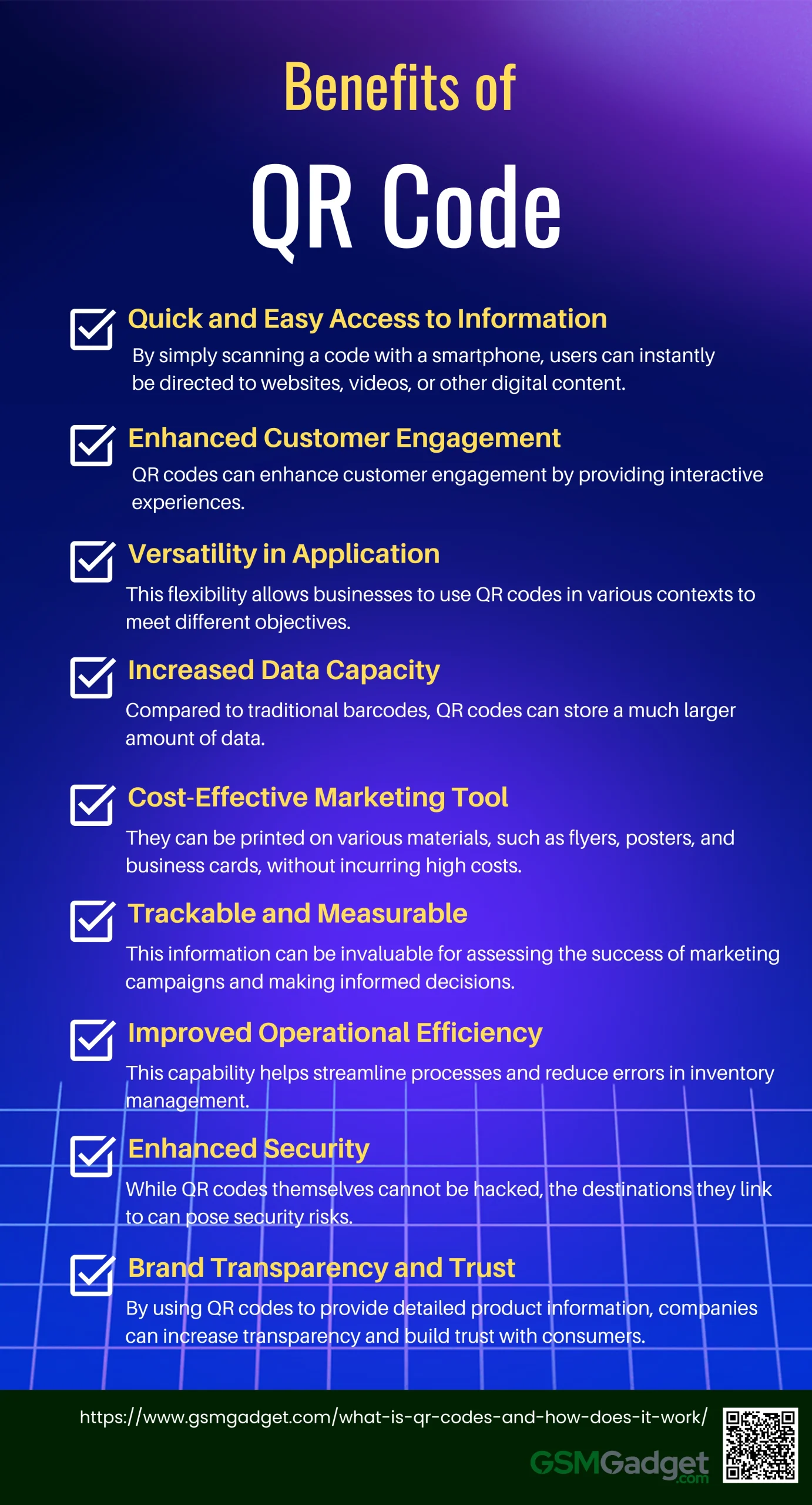
1. Quick and Easy Access to Information
QR codes provide a fast and efficient way to access information. By simply scanning a code with a smartphone, users can instantly be directed to websites, videos, or other digital content without the need to manually enter URLs or search for information.
2. Enhanced Customer Engagement
QR codes can enhance customer engagement by providing interactive experiences. For example, they can be used in marketing campaigns to direct customers to promotional content, special offers, or social media pages, thereby increasing interaction with the brand.
3. Versatility in Application
QR codes are incredibly versatile and can be used in a wide range of applications, from product labeling and inventory management to event ticketing and advertising. This flexibility allows businesses to use QR codes in various contexts to meet different objectives.
4. Increased Data Capacity
Compared to traditional barcodes, QR codes can store a much larger amount of data. This capability makes them suitable for complex applications that require more information, such as detailed product descriptions or multimedia content.
5. Cost-Effective Marketing Tool
QR codes are a cost-effective way to enhance marketing efforts. They can be printed on various materials, such as flyers, posters, and business cards, without incurring high costs. Additionally, they can bridge the gap between offline and online marketing strategies.
6. Trackable and Measurable
Dynamic QR codes allow businesses to track and measure their effectiveness by providing data on how many times a code has been scanned, when, and where. This information can be invaluable for assessing the success of marketing campaigns and making informed decisions.
7. Improved Operational Efficiency
In supply chain management, QR codes can improve operational efficiency by providing detailed tracking information for products. This capability helps streamline processes and reduce errors in inventory management.
8. Enhanced Security
While QR codes themselves cannot be hacked, the destinations they link to can pose security risks. However, when used responsibly, QR codes can enhance security by providing secure access to information and reducing the need for physical contact, such as in contactless payments.
9. Brand Transparency and Trust
By using QR codes to provide detailed product information, companies can increase transparency and build trust with consumers. For instance, QR codes can link to information about product origins, ingredients, or manufacturing processes, giving consumers confidence in their purchases.
Challenges and Limitations of QR Codes
QR codes have become ubiquitous in modern society, offering a convenient bridge between the physical and digital worlds. However, despite their widespread use and benefits, QR codes present several challenges and limitations. These issues span security concerns, usability problems, and technical difficulties.
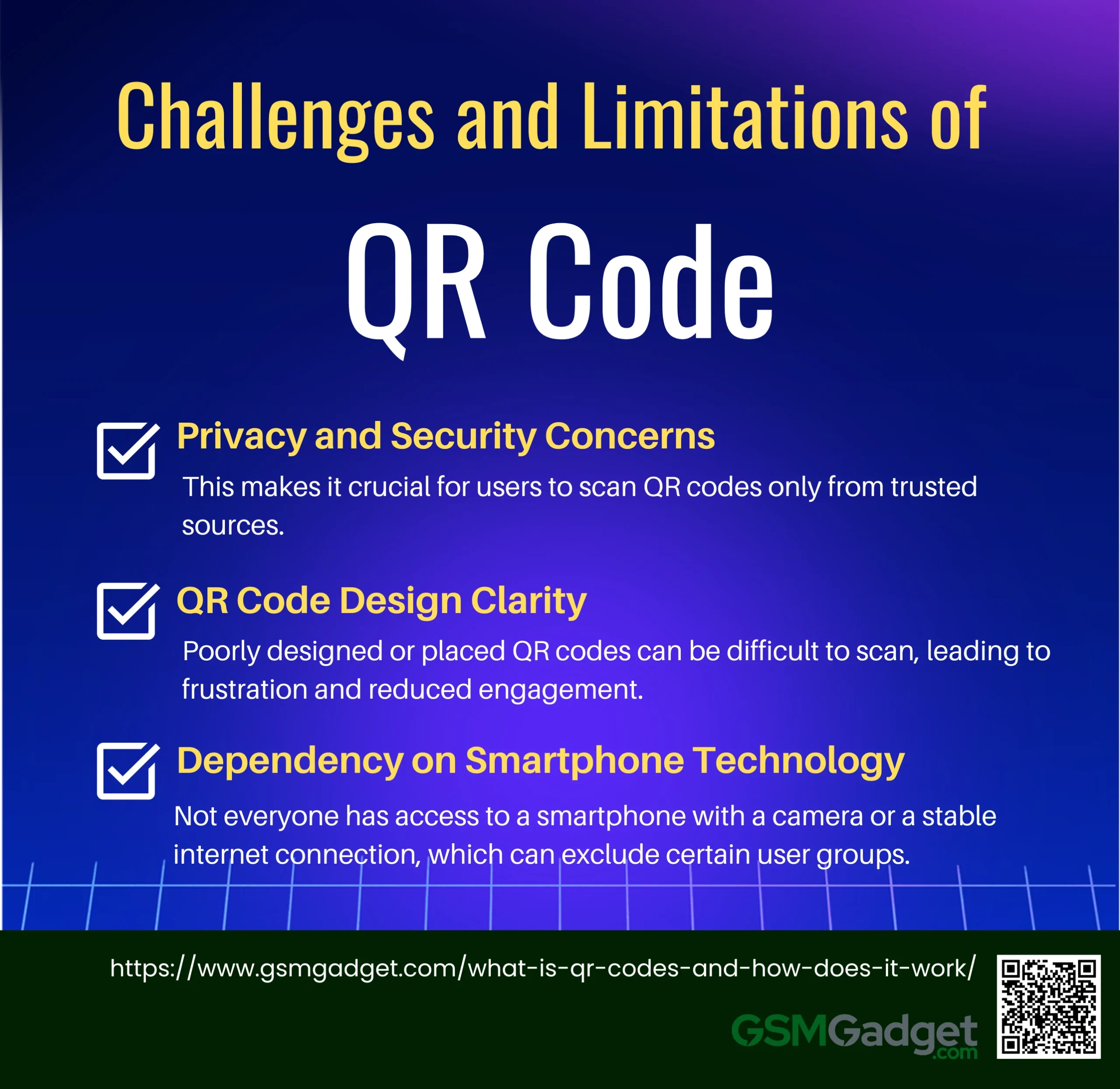
1. Privacy and Security Concerns
One of the main challenges associated with QR codes is their potential for misuse. Cybercriminals can create malicious QR codes that direct users to phishing websites or download malware onto their devices. This makes it crucial for users to scan QR codes only from trusted sources. Additionally, QR codes can mask the destination URL, making it easier for bad actors to deceive users.
2. QR Code Design Clarity
The design and placement of QR codes significantly impact their usability. Poorly designed or placed QR codes can be difficult to scan, leading to frustration and reduced engagement. For instance, overly complex designs or intricate patterns can impede scannability. It’s essential to maintain a simple and clear design to ensure functionality across various devices.
3. Dependency on Smartphone Technology
QR codes rely heavily on smartphone technology, which can be a limitation. Not everyone has access to a smartphone with a camera or a stable internet connection, which can exclude certain user groups. Additionally, QR codes can create accessibility barriers for individuals with visual impairments or motor limitations, who may find it challenging to scan the codes accurately.
How to Create Your Own QR Codes
Creating your own QR codes is a straightforward process that can be accomplished using various tools and platforms. QR codes are versatile and can be used for a range of purposes, from sharing website URLs to embedding contact information. Here’s how you can create your own QR codes and some best practices to follow.
Tools and Platforms for QR Code Generation
Several online tools and platforms allow you to generate QR codes easily. Some popular options include:
- QR Code Generator: A user-friendly platform that offers both static and dynamic QR codes.
- QRStuff: Provides a wide range of QR code types and customization options.
- GOQR.me: Known for its simplicity and ease of use, making it ideal for beginners.
Steps to Create a QR Code
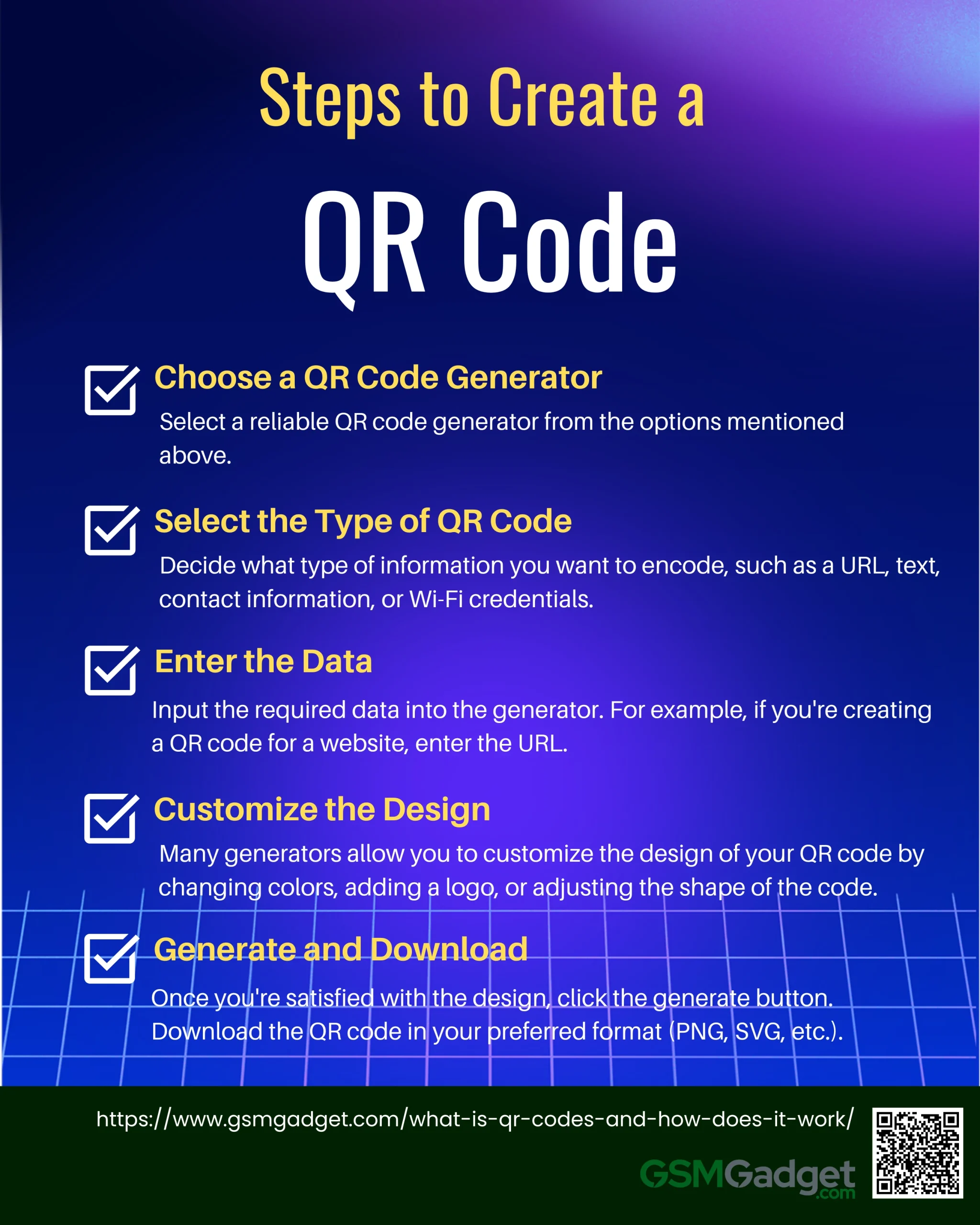
- Choose a QR Code Generator: Select a reliable QR code generator from the options mentioned above.
- Select the Type of QR Code: Decide what type of information you want to encode, such as a URL, text, contact information, or Wi-Fi credentials.
- Enter the Data: Input the required data into the generator. For example, if you’re creating a QR code for a website, enter the URL.
- Customize the Design: Many generators allow you to customize the design of your QR code by changing colors, adding a logo, or adjusting the shape of the code.
- Generate and Download: Once you’re satisfied with the design, click the generate button. Download the QR code in your preferred format (PNG, SVG, etc.).
Best Practices for QR Code Design
To ensure your QR codes are effective and user-friendly, follow these best practices:
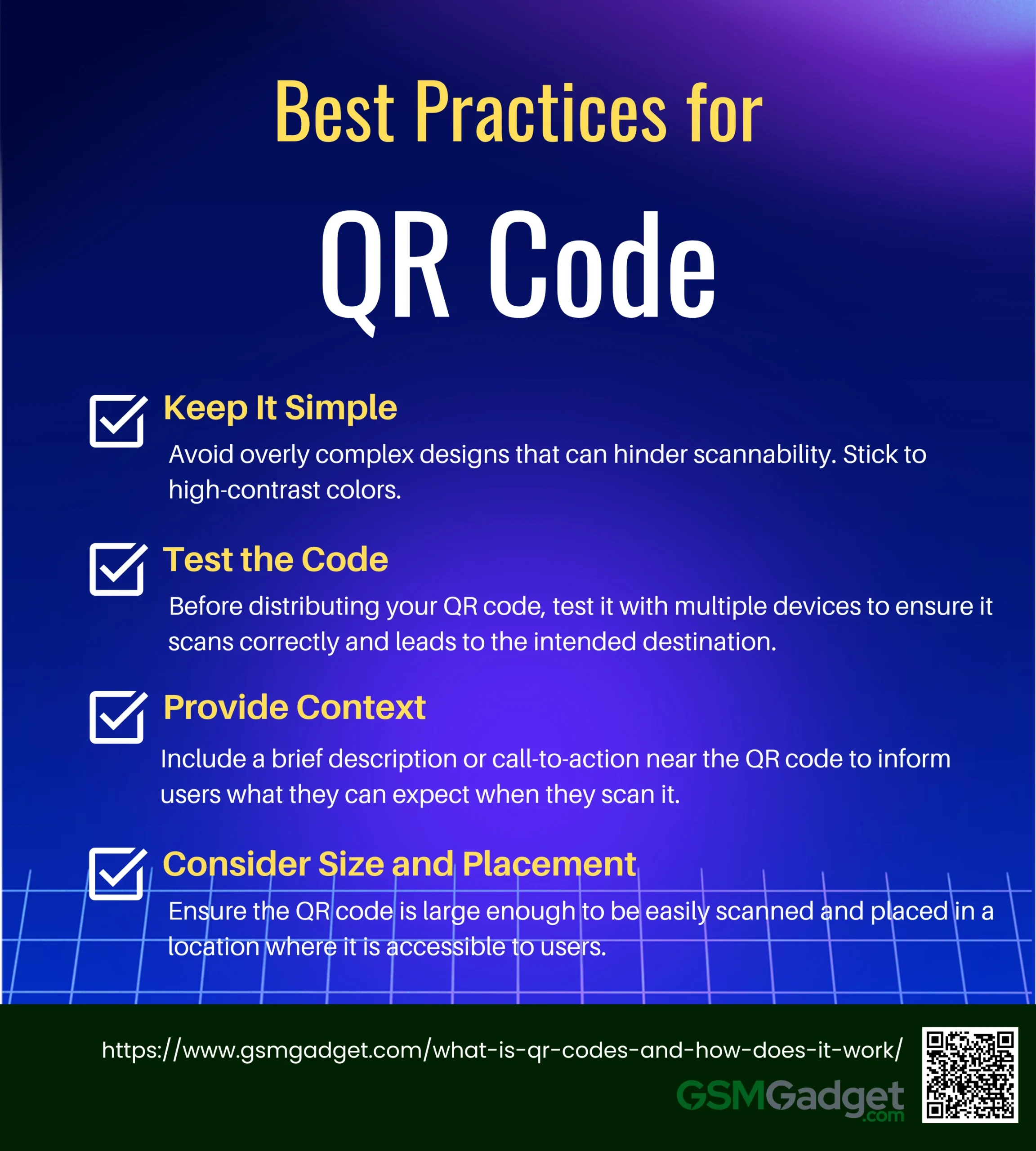
1. Keep It Simple: Avoid overly complex designs that can hinder scannability. Stick to high-contrast colors, typically black and white, to ensure the code is easily readable.
2. Test the Code: Before distributing your QR code, test it with multiple devices to ensure it scans correctly and leads to the intended destination.
3. Provide Context: Include a brief description or call-to-action near the QR code to inform users what they can expect when they scan it. This can increase engagement and trust.
4. Consider Size and Placement: Ensure the QR code is large enough to be easily scanned and placed in a location where it is accessible to users. Avoid placing it in areas with poor lighting or on highly reflective surfaces.
Myths about QR Codes
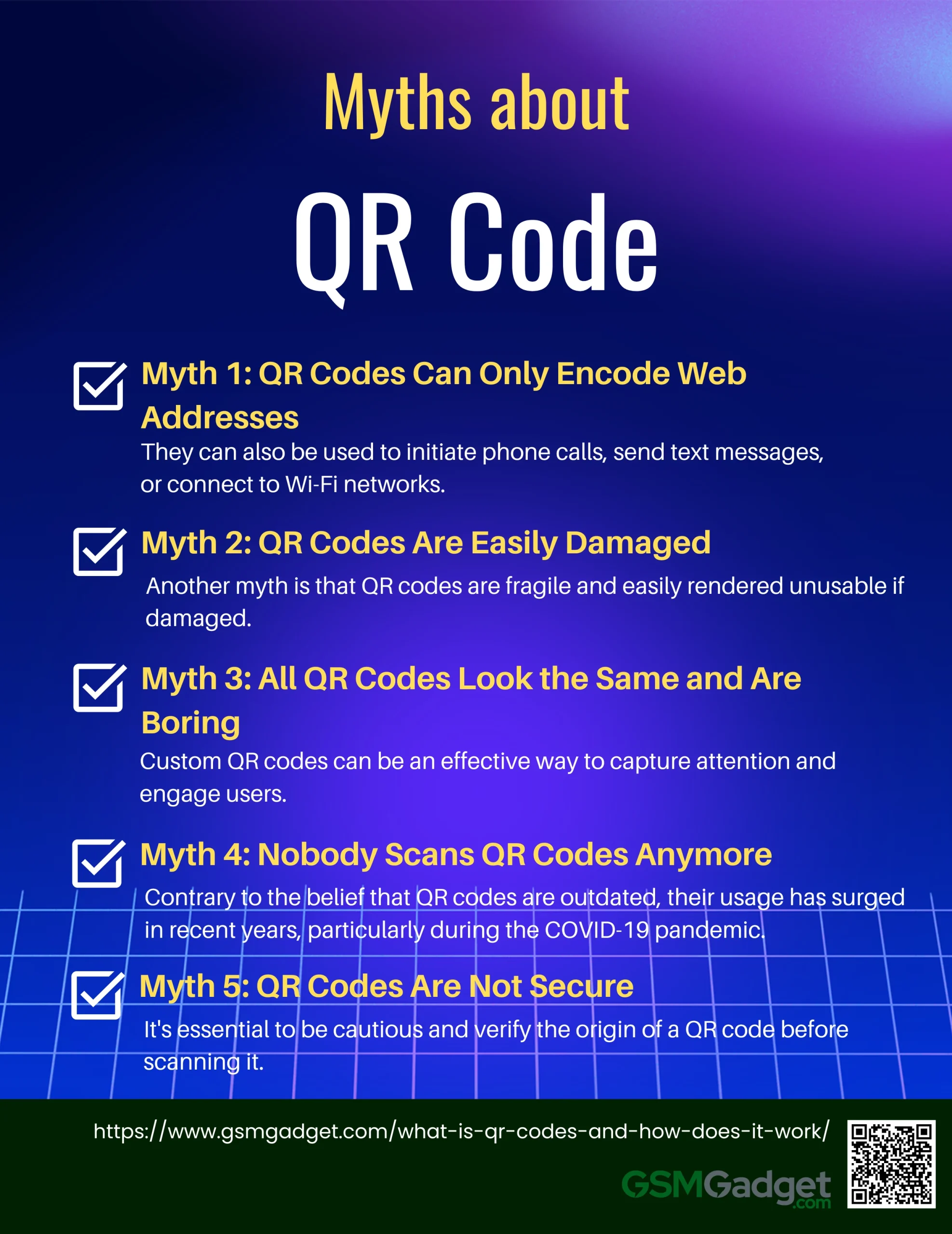
1. Myth 1: QR Codes Can Only Encode Web Addresses
A common misconception is that QR codes are limited to encoding web addresses. In reality, QR codes can store a variety of data types, including contact information, email addresses, phone numbers, and even plain text. They can also be used to initiate phone calls, send text messages, or connect to Wi-Fi networks. This versatility makes QR codes a powerful tool in many different contexts, from marketing to personal use.
2. Myth 2: QR Codes Are Easily Damaged
Another myth is that QR codes are fragile and easily rendered unusable if damaged. In fact, QR codes are designed with error correction capabilities that allow them to function even if up to 30% of the code is damaged or obscured. This robustness ensures that QR codes remain scannable even in less-than-ideal conditions, such as when printed on worn or dirty surfaces.
3. Myth 3: All QR Codes Look the Same and Are Boring
While the traditional black-and-white QR code design is ubiquitous, modern QR codes can be customized with different colors, patterns, and even logos. This customization allows brands to create visually appealing QR codes that align with their branding while still maintaining functionality. Custom QR codes can be an effective way to capture attention and engage users.
4. Myth 4: Nobody Scans QR Codes Anymore
Contrary to the belief that QR codes are outdated, their usage has surged in recent years, particularly during the COVID-19 pandemic. In 2022, 89 million people in the United States scanned a QR code using their mobile devices, a significant increase from previous years. QR codes are widely used in various applications, from restaurant menus to contactless payments, proving their continued relevance and utility.
5. Myth 5: QR Codes Are Not Secure
While QR codes themselves cannot carry viruses, they can link to malicious websites or trigger unwanted actions if scanned from an untrusted source. However, this risk can be mitigated by only scanning QR codes from reputable sources and using security software to detect malicious links. It’s essential to be cautious and verify the origin of a QR code before scanning it.
Conclusion
QR codes have transformed the way we interact with information, bridging the gap between the physical and digital worlds. Their versatility allows for a wide range of applications, from marketing and payments to healthcare and logistics, making them invaluable tools in various industries. Despite their many advantages, including high data capacity and ease of use, challenges such as security concerns and reliance on smartphone technology must be addressed to maximize their potential. As QR codes continue to evolve, understanding their functionalities and best practices for implementation will be crucial for businesses and consumers alike, ensuring safe and effective usage in our increasingly digital landscape.
FAQs
1. Can QR Codes be used offline?
Yes, QR codes can be used offline. They can store information such as text, contact details, or Wi-Fi credentials that do not require an internet connection to access. However, if the QR code links to a website or online resource, an internet connection will be needed to access that content.
2. How long do QR Codes last?
QR codes do not have an expiration date and can last indefinitely as long as they are not physically damaged or altered. However, the content they link to (such as a website) may change or become unavailable over time.
3. Can QR Codes be resized without losing functionality?
Yes, QR codes can be resized without losing functionality, but they should be scaled proportionally to ensure they remain scannable. It’s important to maintain sufficient contrast between the code and its background and to test the QR code after resizing to ensure it works correctly.
4. Are there any costs associated with using QR Codes?
Creating and using QR codes can be free or paid, depending on the service and features required. Many basic QR code generators are free, but dynamic QR codes with tracking, analytics, and editing capabilities may come with a subscription fee.
5. Can QR Codes be scanned through a screen or glass?
Yes, QR codes can be scanned from a screen or through glass as long as there is no significant glare or reflection that obstructs the camera’s view of the code. The key is to ensure the QR code is clear and visible to the scanning device.
6. What is the maximum distance at which a QR Code can be scanned?
The maximum distance at which a QR code can be scanned depends on the size and resolution of the code and the quality of the scanner. Generally, larger QR codes can be scanned from a greater distance. A rule of thumb is that the scanning distance should be about 10 times the width of the QR code.
7. Can QR Codes be used to track inventory?
Yes, QR codes can be used to track inventory. They can store information about the product, including serial numbers, batch numbers, and other relevant details, which can be scanned to update inventory records or track product movement in the supply chain.
8. Can QR Codes store multimedia content directly?
QR codes cannot store multimedia content directly due to their data capacity limitations. However, they can link to multimedia content stored online, such as videos, audio files, or images, enabling users to access this content by scanning the code.
9. Is it possible to create a QR Code that only works for a specific period?
Yes, it is possible to create a time-limited QR code using dynamic QR code services. These codes can be set to redirect to specific content only for a certain period, after which they can be updated to lead to different content or become inactive.
10. Can QR Codes be encrypted for added security?
While QR codes themselves are not inherently encrypted, the data they store can be encrypted before being embedded into the QR code. Additionally, specialized QR codes like Secure Quick Response (SQRC) codes offer a layer of security by restricting access to certain readers.
11. What happens if a QR Code is scanned in poor lighting conditions?
Scanning a QR code in poor lighting can be challenging, but modern smartphone cameras are often equipped with low-light capabilities that can help in these situations. Additionally, users can manually increase screen brightness or use a flashlight to improve the chances of a successful scan.
12. Can QR Codes be used to share social media profiles?
Yes, QR codes can be used to link directly to social media profiles, pages, or specific posts. This makes it easy for users to connect with businesses or individuals on various social media platforms by scanning the code.
